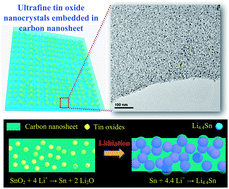In situ growth of ultrafine tin oxide nanocrystals embedded in graphitized carbon nanosheets for use in high-performance lithium-ion batteries†
Abstract
A crystal-facet-induced formation method has been developed for the fabrication of graphitized carbon nanosheets (CNS) embedded with ultrafine SnO2 nanocrystals grown in situ upon calcination under a N2 atmosphere. The obtained SnO2–CNS composite exhibits superior electrochemical performance when used as the anode material for lithium-ion batteries. Cycled at high current densities of 0.5, 1.0 and 10.0 A g−1 for 50 cycles, the composite material delivers large discharge capacities of 826, 728, and 400 mA h g−1, respectively. The graphitized carbon nanosheets facilitate both ion and electron transportation and act as an efficient buffer to accommodate the volume changes generated upon Li-ion insertion–extraction. The ultrafine SnO2 nanocrystals significantly shorten the diffusion distances of the lithium ions and also provide a large contact area for the interface reaction between the anode material and lithium-ions during lithiation or delithiation, leading to a remarkably high specific capacity and good cycling stability.


 Please wait while we load your content...
Please wait while we load your content...